Panamint Valley, CA
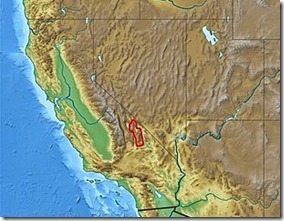 Not too long ago, before California became Waterworld II (winter 2022-23), we ventured out toward a relatively little-known area in eastern California. Although everybody has heard of Death Valley, most people haven’t heard of Panamint Valley; it’s just west 50 miles or so from the more famous spot, and in my humble opinion, just as beautiful and worth a visit in its own right. Plus, it’s way lonely and lacking crowds; big, vast, and peaceful, just the way we like it.
Not too long ago, before California became Waterworld II (winter 2022-23), we ventured out toward a relatively little-known area in eastern California. Although everybody has heard of Death Valley, most people haven’t heard of Panamint Valley; it’s just west 50 miles or so from the more famous spot, and in my humble opinion, just as beautiful and worth a visit in its own right. Plus, it’s way lonely and lacking crowds; big, vast, and peaceful, just the way we like it.
You can get into Panamint Valley (when the roads have not been washed out or split with earthquakes) via CA-190 in the north (that’s the road to Death Valley), or via CA-178, Ridgecrest, and Trona from the south. That said, it’s pretty easy to get there, but not really straightforward.
On the Way – “Pond” Isabella
Coming from the Bay area, we opted to spend a couple of days relaxing at what used to be the shore of Lake Isabella. What a sight… the lake was at about 8% capacity. You read that right. This photo shows where the northern shoreline used to be — it’s the medium-colored band of beige, curving through the lower-middle of the frame. All the very-light beige used to be underwater.
Standing on the ground at lake-level, there is barely a glimpse of water anywhere. But watch out anyway, the old flat lakebed is treacherous, with sand and/or mud just beneath the surface. Howie’s 4×4 gear dragged us nicely through some very soft spots.
Here, looking north toward where Howie is parked, I would have been several feet underwater on our last visit.
Out on the middle of the now-dry lakebed, it was amazing how fast and high the brush had grown up. Karin was ahead in Jayk, but she had to get out often, and move some of the more intrusive branches to keep Howie from getting impaled.
This old stump was actually left over from the original clearing of the land (for the Lake) back in 1948.
It had been underwater until just a few years ago.
There was plenty to do around the area, and we could easily have spent many days exploring the Lake, Kernville, Kern Valley, and so forth. But we were headed for our longer stay out in Panamint, so we boogied eastward after only a few days. Ironically, we had no idea that the Lake was going to fill up within 6 months (!!!!). We’ll likely never have quite the same opportunity again. Ah well.
Inyokern, Ridgecrest, Trona
Heading east on CA-178, we climbed over Walker Pass (5259′). What a relief, the last time through there, Howie was having brutal overheating problems; this time, piece of cake. Heading down the eastern side, then jogging north up CA-14, we passed through these three very different desert towns.
INYOKERN is almost a whistle-stop, but noteworthy to us for the outstanding Gateway country hardware store (think Ace/True-Value type), with a pull-through water-fill service, $5. Wow. It’s right off the 14 on 178, always an easy stop.
RIDGECREST is the true center of this part of the desert. Big spread-out town of 30,000 or so, with Home Depot, churches, and food joints grand and simple. It’s literally glued to the bottom edge of China Lake NWS (Naval Weapons Station), from which emanate some of the most diverse military aircraft, and the best free desert air shows, that you’ll ever see.
TRONA is about 24 miles past Ridgecrest. It’s hard to describe Trona without sounding unduly negative. It’s a once-booming mining town that’s just been beat to death by mine closings, earthquakes and weather. Barely-surviving businesses have closed, and much of the town is forlornly shuttered. There are still two gas stations active, and a small market/general store. And the remaining community is still mostly employed at the nearby active mines like Searles Valley Minerals. But there’s more to the picture, most of which we’ve never explored. Trona is the registered principality for over 12,000 registered mines in the area (not all active of course). It’s easy to understand why it was once a boom town. We’re going to have to do some more exploring there some day.
Up Into Panamint Valley
Leaving Trona behind, we headed north on what seemed like a continuation of CA-178, but at that point it’s actually Trona-Wildrose Road. The traveling gets interesting and pretty, going through a low range of hills and dropping down into the Valley proper.
Previously (a few blog posts back), we’d gone into the Trona Pinnacles area, and also up into the middle of the Valley to Surprise Canyon on the eastern side. But this trip, we wanted to explore more westward — so we picked the ancient pavement of Nadeau Road to wander up into the lonely spaces of a lonely Valley.
Coming out of the hills north of Trona, the Valley unfolds ahead. The western (left) flank is where we want to go. The Panamint mountains are on the right, and the Argus Range is on the left.
Eventually, after driving out Nadeau Road for many miles, we took a left on a mostly-decent dirt track, drove up toward the Argus Range a few more miles, and found a nice lonely spot with a grand view. (We took this photo on a later exploration driving Jayk.) As you may already know, we’re not that keen on neighbors when we boondock; we had none.
From our vantage point, we had a splendid view of the Valley: all the way across to Surprise Canyon and Ballarat, our previous haunts; all the way up to CA-190; and all the way back to the hills north of Trona. All features were miniaturized against the gorgeous pastel paintings of the Panamint Mountains.
We were probably 40 miles from the nearest cell tower, and we got to try out our new-to-us mobile Starlink setup, which worked perfectly. A lonely, vast desert of beatific isolation, with full Internet access. Wicked cool.
The Chinese Wall
When I was researching points of interest near Panamint, I ran across a fascinating bit of history, and we wanted to see it close-up. We set off to go see “the Chinese wall”, a series of stone-mason works and roadbed structures created to host transportation from LA to the Panamint Mine. It was built way back, circa 1865 or so, and actually began as a toll road. (There’s some more very cool history on all of this on digital-desert.com.)
To get there, we back-tracked to Trona Road, and then through trial-and-error we found the rough dirt track into the back-country of the hills we’d previously climbed through when we left Trona. The road was long and rough, and well-eroded in spots, but the basic foundation was still there, 150+ years after its construction. Every.single.stone.laid.by.hand.
It all still looked wide enough and strong enough to support a fully-loaded semi-truck.
Another striking feature, though hard to see the intended function, was the scattering of stone “huts”, little more than coffin-sized piles of rocks. These were the sleeping quarters where the stoneworkers spent their nights. Dang. Harsh land, harsh times.
The history of the area is a fascinating read; the guy for whom Nadeau Road was named was courageous, entrepreneurial, crafty, and of marginal ethics by some accounts. You can read up if you like and make up your own mind. Regardless of his character, he left a lasting mark on the geology and economics of Panamint Valley. His roads were instrumental in enabling the multitudinous mining interests.
While we were scoping out his projects, a couple of local burros showed some interest in us, but they, unlike others in the area, didn’t seem to want to come close. This one was very happy to check our progress from 100 yards away or so.
BITS and PIECES
After finding such a nice camp, we stayed in the Valley for about a week, and just poked around to see what we could see. Some days we just hung out at camp and made local walks/hikes; other times, we took Jayk farther away. The weather varied from gorgeous to skanky; we got some wind, but not much in the way of rain, just a few sprinkles. Plenty of overcast to shadow our solar panels, so we actually ran our little generator for a few hours one day, to get our batteries charged back up.
Here are some snippets of life in various parts of the Valley…
Panamint Valley Crater
A CRATER?!?! Well OK, just don’t get your hopes too high. This is a baby crater by any standards. In fact, you have to really dig into a satellite map to find it, because it’s too small a feature to register on any topo. Try zooming in to 36.0973, -117.3744 for a look.
It was a short drive-and-hike from our camp. It’s a pretty interesting feature, because at 230′ wide by 40′ deep, a meteorite impact or bomb explosion should have created characteristics that are absent. There is no raised lip, no scattering outside the rim, no crushing or shattering of rocks within the crater proper. No evidence either of steam or explosive volcanic origin. The best guess as of today is that it is a “collapse crater”, created by an underground geologic void into which the overlying strata somewhat peacefully fell. Almost like a giant sinkhole. Its age is estimated at anywhere from a handful of decades to a few thousand years.
Not so Wild-Life
Back in the hills north of Trona, the donkeys were a bit shy, even skittish. Down here in the Valley, I’m thinking that they’re routinely fed by Death Valley tourists. They have no hesitancy to come looking for a handout (which we do NOT do).
Somebody’s Mine
Way up at the end of the paved section of Nadeau Road, there’s an active mine: fences, locked gates, equipment, etc. This belongs to Panamint Valley Limestone and is a going concern. Mildly interesting to look at, but nothing we wanted to spend much time at. And, with 12,000+ old mines in the general area, there’s no shortage of places to explore.
Prime example: Up Shepherd Canyon a few miles is this odd remnant of a former mine, the Shepherd Canyon Tungsten Mine. There’s not much remaining in old structures or abandoned equipment, but there is this enormous concrete slab, the purpose of which we can only guess. It’s big enough to park 30 cars on, and sturdy enough for any equipment I can imagine. No idea what it’s for. This mine was used in WW2 and was only active from 1942-1945, when the war’s end reduced the demand for tungsten
There’s even another slab a little ways away, and just as inscrutable. On a small hill near the slabs, substantial digging was clearly done. For what? Dunno. The only piece of equipment we spotted, an old trailer, sits and rusts. Probably a gas-powered compressor. And not even the usual bullet-hole collection.
Just Looking Around
When you’re driving quickly through the desert, it has a somewhat uniform appearance; there’s the impression that you could just get out of the car and stroll across it. In most cases, this is categorically NOT true.
We were parked/camped at a “crossroads” of two dirt tracks. But that term can be deceptive. With weathering and flash flooding, even the best of freshly-bulldozed mine-access roads will eventually become difficult terrain for man or beast (or Jeep).
Most afternoons, we’d take a walk (hike) (scramble) away from camp and across the local terrain. Sometimes it was a stroll, but most times it was a loose, gravelly ankle-twisting affair. At a leisurely walking pace at ground level, there’s never a shortage of stuff to grab attention. Rocks, obviously. Miniscule wildflowers, any time of year. Animal burrows of all shapes and sizes. Endless entertainment and — in the steep and rocky spots — adventure. Watching our footing while watching for rattlers. Focus.
The road ahead… Looks easy, right? Or maybe there are some touchy spots?
Yup… This track goes for many miles — if you have the time and/or equipment to follow it. Washouts like this, and other “variations” need a 4X4 with good clearance and good driving skills. Even then, some occasional bypasses or mini-road-building is called for.
When we weren’t hiking, or lounging around camp, we were out exploring in Jayk, mostly on roads like that one above. Here, from rising terrain, it’s more clear how rough the “smooth featureless desert” can actually be. Those prominent runoff channels’ embankments are 10′-20′ high and sloped at 60 degrees or steeper. Hundreds of lesser ones, unseen, make the ground irregular to say the least. These kinds of features punctuate the slopes throughout the entire Valley; more-so on the western (Argus Range) side, which is a bit more sloped.
Entertainment, Courtesy USN
Did I mention the “airshows”? China Lake is a major Naval Aviation training center, and flights of all kinds of military hardware occur daily, and even on weekends occasionally. The valley floor is mostly without hills, long and wide, and virtually uninhabited, so it’s very adaptable to low-level flight training in particular.
Although we saw many sorties all week long, I only snapped this one picture on this visit (I have tons of pictures saved away already). A C-130 cruised sedately by at a nice low altitude, making for a clear, easy shot. He was maybe a half-mile away and 500-1000′ high (hard to estimate, I could be way off).
A vast space, a fine Jeep, a fine woman, a robust Internet connection…
… is there any more a man could ask? I think not.
When our time was nearly over, we waited as long as possible, and then opted to drive straight through to home in one day, a relatively long trip for us at 400 miles. But it was smooth and uneventful, and we got home before some nasty weather that was approaching California; the beginning of what was to become a record winter series of storms.
It was a peaceful, interesting, beautiful week-plus; just the kind of getaway that makes you feel like the world is a great place to live in.
And, well, it is. Life is Good.
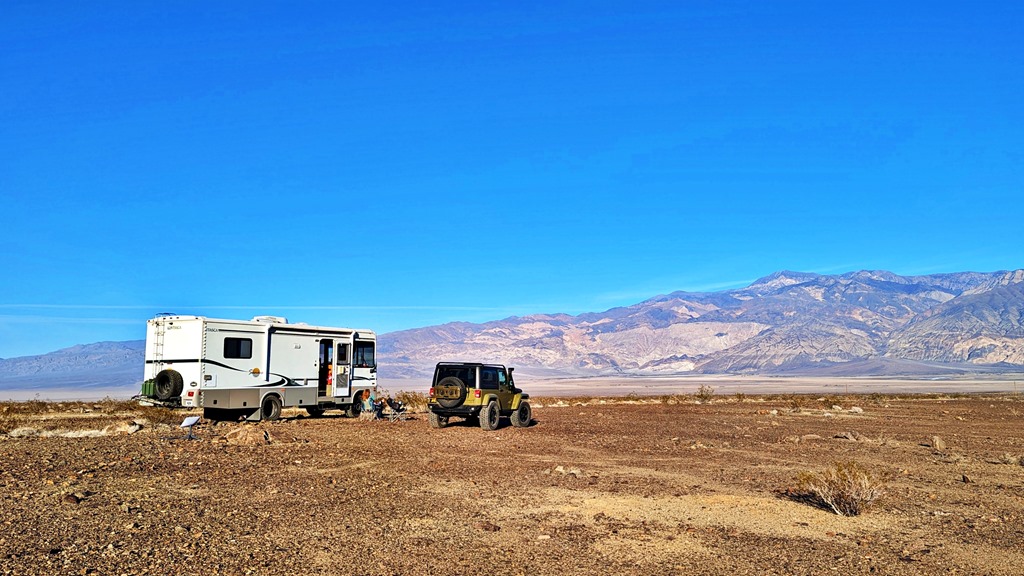
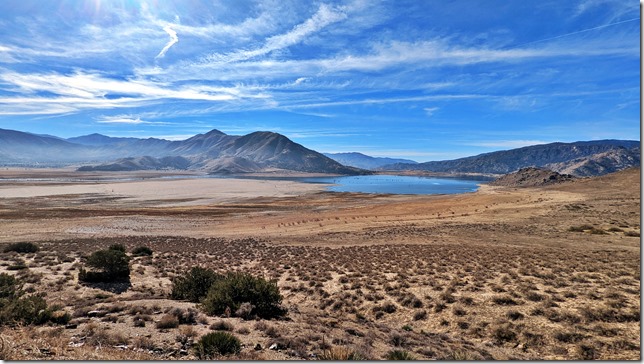
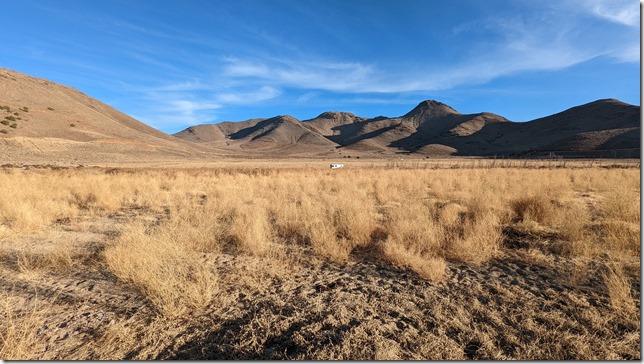
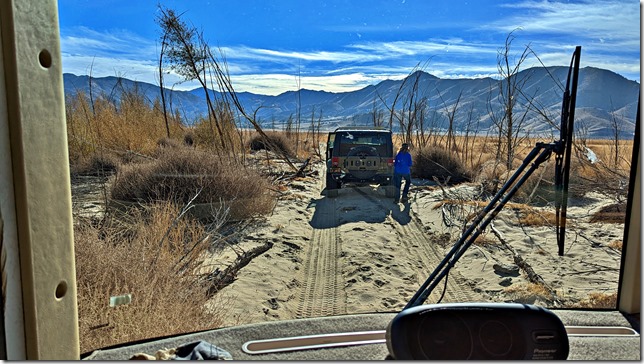
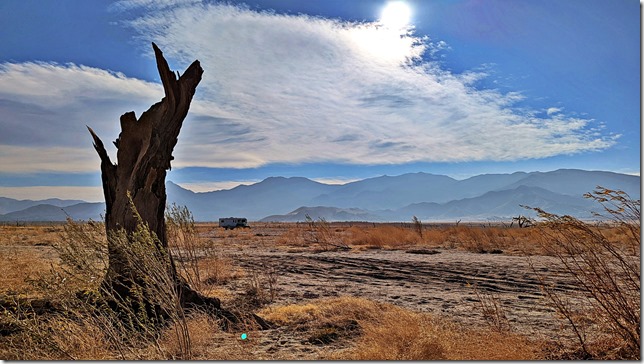
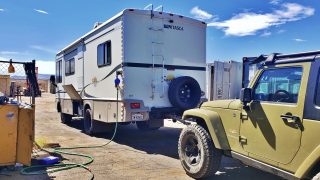
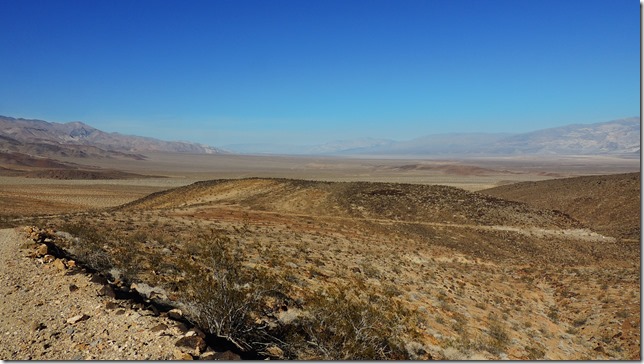
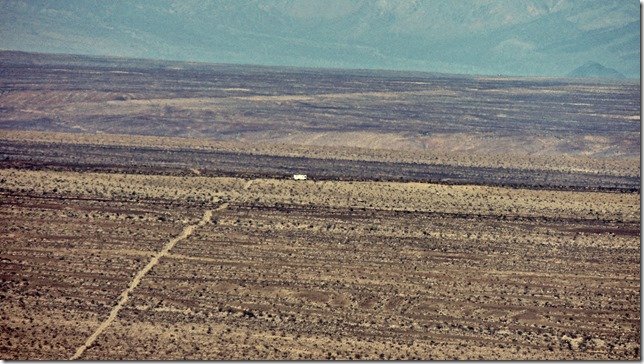
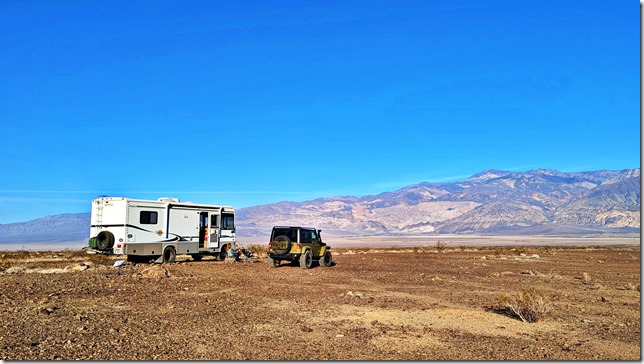
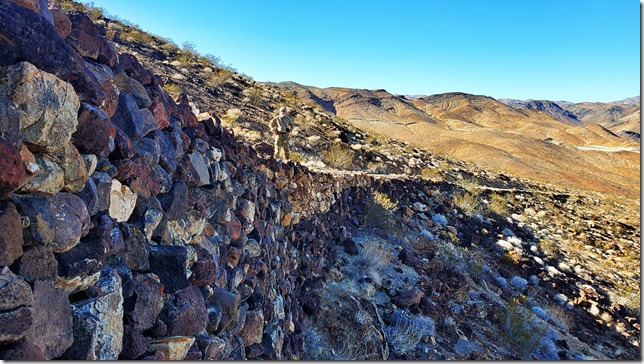
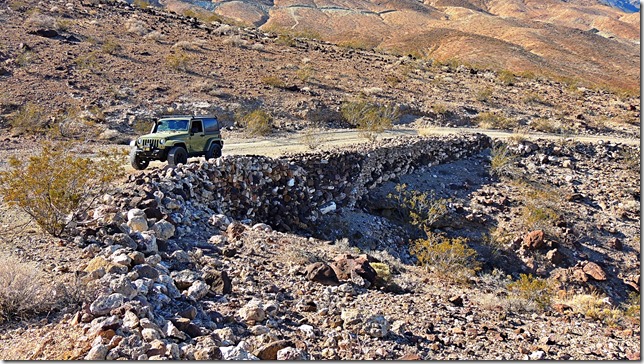
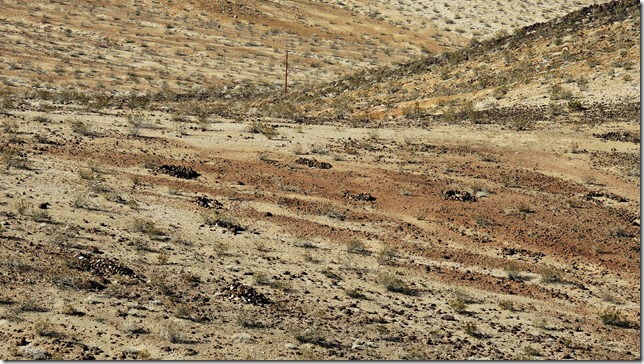
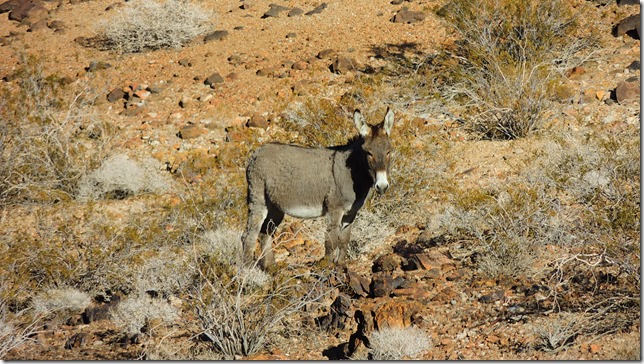
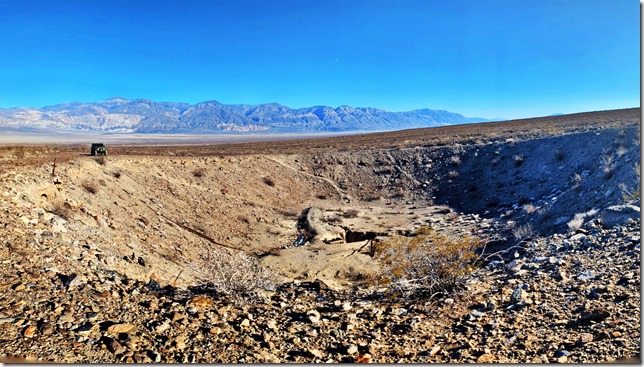
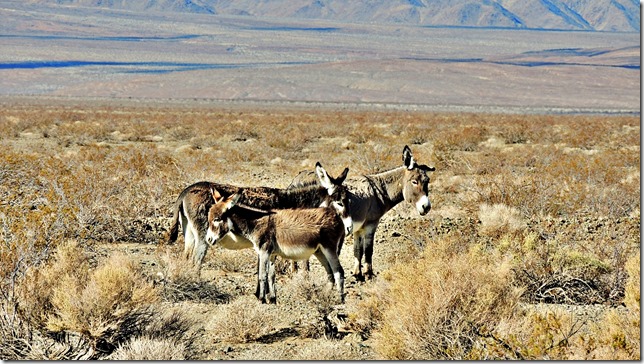
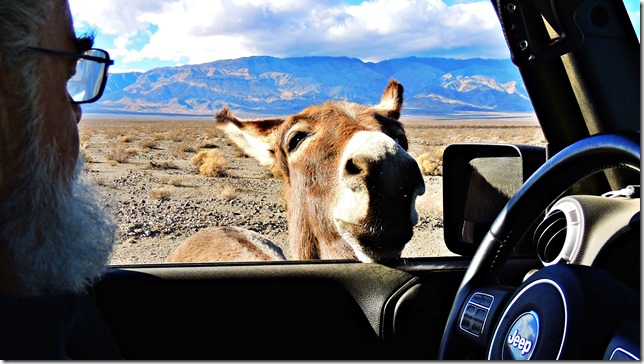
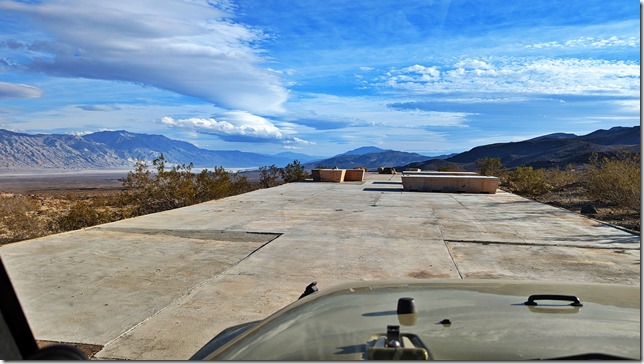
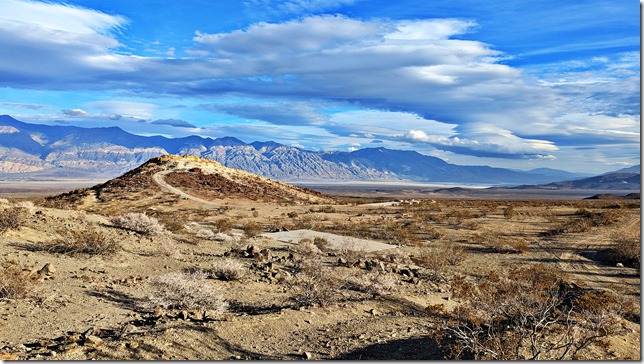
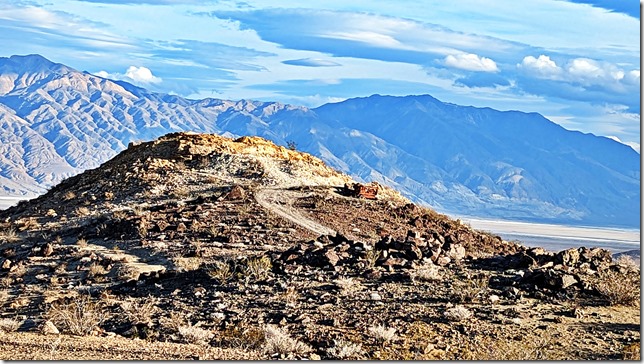
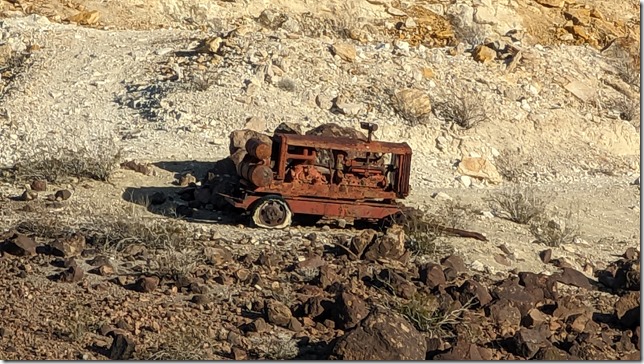
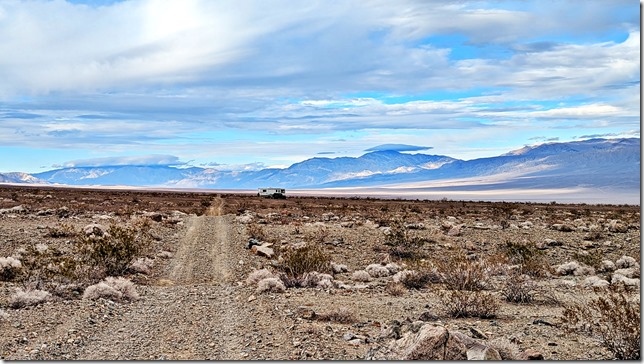
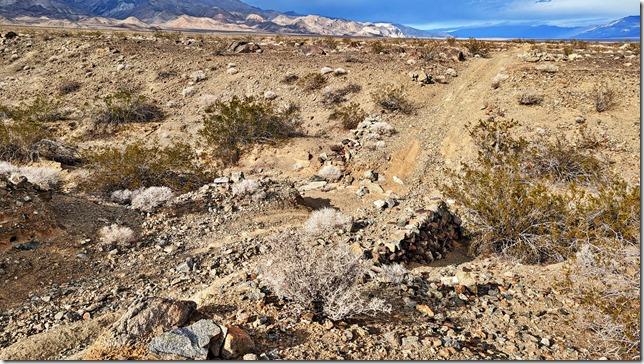
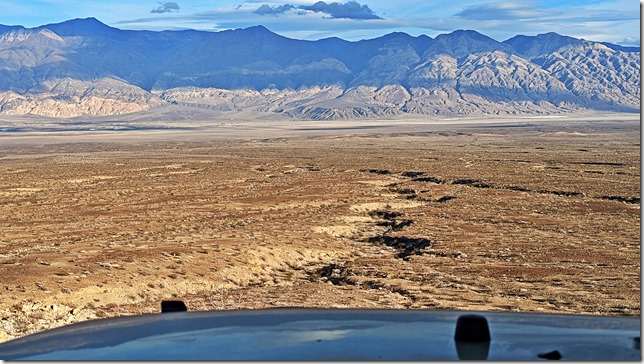
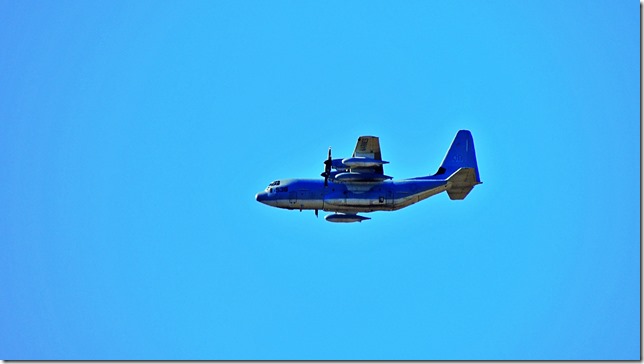
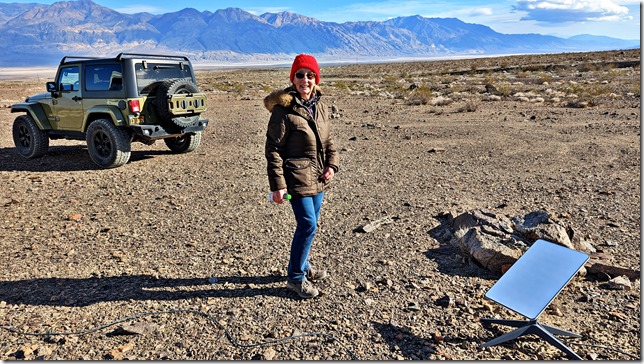
Love these wonderful adventures and updates. Living them vicariously through you. Safe travels.
Hank Fore
What a nice travel you did before we arrived in SF… next time we will be earlier and will spent together at least a part of this trip. Great pictures from a great travel!
As usual, a great report. We drive through the area a couple of times a year on our way to the Eastern Sierra from San Diego County, but other than driving to Death Valley, we haven’t stopped in Trona or Panamint Valley.
Shoulda, woulda, coulda. I must make an effort to go and visit. Thanks!
Will, the Trona Pinnacles are quite a sight. Except for 5 miles of washboard, they’re easy to get to.
We passed them by for decades, and finally visited a couple of years ago.
Well worth the stopover/camping, highly recommended.